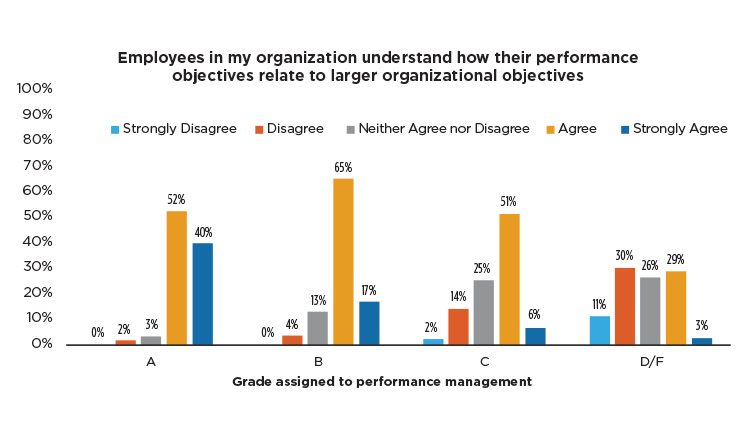Learning to effectively manage and motivate employees is one way agribusinesses are looking to gain a competitive edge.
There’s definitely room for improvement. At least that’s what many in agribusiness believe about how performance interacts with overall business goals. According to a recent survey conducted by Purdue University’s Center for Food and Agricultural Business, more than half of all middle managers in agribusiness believe their organizations are ineffective at performance management.
Michael Gunderson, associate director of the center and associate professor of agricultural economics at Purdue, conducted the survey to help clients who are struggling with employee performance.
“The biggest challenge for most food and agribusiness companies is not only having the right talent, but helping those individuals perform,” Gunderson says.
The survey gauged how various companies ranked themselves in regards to performance management within their organization and correlated the effectiveness of performance management with revenue growth, employee growth and overall company performance. Findings were presented at the recent National Conference for Agribusiness, held Nov. 10-11 in Lafayette, Ind.
“Performance management links an individual’s goals to the company’s goals,” Gunderson says. “It is a key step of talent management.”
Allan Gray, director of the Center for Food and Agricultural Business, believes performance management is now more important than ever before.
Gray says during the past few years, he has noticed a disconnect between what managers believe about their employees and how those employees really align with company goals.
“Leaders often tell us their people are their greatest strength as a company, but then say they struggle with meeting goals and productivity,” Gray says.
That disconnect is especially important when faced with a changing agricultural industry in which companies must become more competitive to move forward in the market.
“The market isn’t going to carry you anymore. If you want to succeed, you have to be better than your competitors, and that’s done by better managing your people. We need to get people thinking more about that process,” Gray says.
Thus, the survey, which helped Purdue researchers get an idea of where more companies were starting out on the scale in a quest for the best employee performance.
A similar study, conducted at by the National Center for the Middle Market, a partnership between GE Capital and The Ohio State University’s Fisher College of Business, inspired the Purdue team. Their survey questioned more than 400 C-suite executives at middle-market companies with revenue between $10 million and $1 billion about the connection between performance management and the bottom line of their organizations.
The Purdue study, which was open during February and March 2015, asked participants Likert scale-style questions about their performance management effectiveness. More than 700 usable responses were collected.
Source: Purdue University Center for Food and Agricultural Business.
Ways to Improve
Gunderson says the survey proves there is significant potential for growth.
One of the key findings showed human resource departments, which acted more as a strategic advisor for employees rather than just an administrative branch, had much more effective performance management, with a much better alignment between employee and business goals.
“Performance management can’t be a task that’s delegated solely to HR,” Gunderson says. “It has to be a partnership between all levels of managers.”
However, some companies have such a small staff that there is no human resource department to partner with in this effort.
Todd Burrus, part owner of Burrus Seed Farms, Inc., in Arenzville, Ill., attended the conference and was impressed with the information, even though his own organization doesn’t compare, in terms of size, to most of the presenters. Still, he found the idea of performance management to be relevant to everyone, no matter how few employees.
“The ideas might be different but the basic human needs of significance and security are the same for every employee on your staff. Performance management focuses on meeting those needs and doing it in a fashion that incorporates those needs into your overall business goals,” Burrus says.
Another significant finding showed that though managers sometimes feel they are doing a good job, many employees don’t feel they receive effective feedback.
“Managers may think they are communicating effectively, but that’s not always the case,” Gunderson says.
One way to help close that gap might be to reshape the entire performance management system, if a company even has one in place.
“It’s often viewed as busy work,” Gunderson says. “Companies need to find a solution for providing feedback that is quick and effective. It’s also probably wise to focus on feedback more than just once a year for an annual review cycle.”
Gray says the key to improving performance management is to not only think about setting goals and using metrics to track them, but to also focus on developing people.
“We have to give people the tools they need to achieve their goals,” he says.
Burrus says the survey helped affirm some recent changes the company had made.
“We’re taking steps in that direction, and we came away feeling the results are going to follow those efforts,” he says, mentioning strategic goals, alignment within the organization and effective incentives as the key reasons to focus on performance management.
However, one of the main takeaways for Burrus was to think about the company’s younger generations of workers.
“One of the things I found particularly interesting was the focus on looking into keeping those younger folks well-engaged and aligned with company goals,” Burrus says. “There were several good ideas to think about there.”
Gray agrees. “The biggest reason more companies are thinking about performance management is the sense of urgency they feel to develop succession plans to combat the age gap we’re seeing within the food and agribusiness industry,” he says.
Upper management is composed almost entirely by older generations, and there’s a significant age, and experience, gap between the next generation of leaders.
“We need to start training leaders how to manage others and help them learn effective employee management skills,” Gray says. “It’s about helping people understand goals and how they connect to the company. Employees can’t improve unless their managers are very clear about setting and achieving goals.”
One good thing about taking the time to focus on these strategies is that improvement can often be seen almost immediately, despite a learning curve.
“We’ll have to spend time training managers and coaching employees on the new metrics, so there’s a transitional period,” Gray says. “But I believe companies will see impacts right away, simply because their tools for setting and measuring goals will be more effective.”
Get Started
For organizations wanting to improve performance management, Gunderson recommends starting with three simple steps.
1. Consider scrapping the annual review. Many successful companies have moved to an environment that nurtures ongoing feedback between all employees. “One of our speakers from GE shared that the company uses a few minutes after each meeting to focus on things to both ‘continue doing’ and ‘consider doing differently.’ That language is really permeating the entire organization now and helping foster development,” Gunderson says.
2. Don’t force the “bell curve.” Normal distribution theory suggests all companies have a small number of very high performers and a similar number of very low performers with the bulk of employees performing near the average, but Gunderson says many successful companies are abandoning this idea. “Distributions were made famous by Jack Welch during his time at GE, but even they no longer use that system. There are many problems associated with this model and it might not fully reflect the full diversity of people, roles, and the alignment of the two,” he says.
3. Skip the self-assessment. This annual process is often dreaded by employees, but more than that, it’s ineffective. “Research suggests that we are notoriously poor self-evaluators,” Gunderson says. “With the goal of keeping performance reviews simple and effective, self-assessment makes them more complicated and might lead to them being less effective.”














